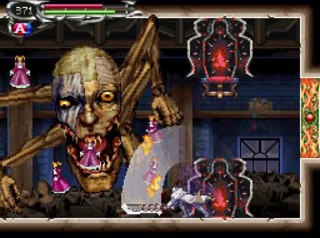Overview
Castlevania: Dawn of Sorrow (known in Japan as Akumajou Dracula: Sougetsu no Juujika, loosely translated to "Devil's Castle Dracula: Cross of the Blue Moon") is a 2D horror-fantasy platformer-adventure game developed by KCE Tokyo and published by Konami for the Nintendo DS on October 4, 2005.
The sequel to Castlevania: Aria of Sorrow, Dawn of Sorrow is the first Castlevania game developed for the DS and the fifth game in the series to have the gameplay style of free-roaming backtrack-focused exploration with RPG-style attribute, inventory, and experience systems. It is also one of the few Castlevania games to use an anime-inspired art style for its characters.
The game's story takes place in the year 2036, one year after main protagonist Soma Cruz is revealed to be the reincarnation of the vampire Dracula. After being attacked by the shadow priestess Celia Fortner (who leads an evil cult dedicated to assuming the mantle of Dracula), Soma decides to investigate the cult and re-establish his dark powers.
Along with Aria of Sorrow's signature "Tactical Soul" mechanic, the game introduces the "Magic Seal" system, where players must draw patterns using the DS touchscreen to finish off boss enemies. The game also has a unique bonus "Enemy Set Mode", where players can create their own dungeons using Souls found throughout the game and can race other players (through wireless multiplayer) to achieve the fastest time. Wireless multiplayer can also be used to trade Souls.
The game also improves the unlockable "Julius Mode" from the previous game, allowing players to switch from three separate characters on-the-fly (which was later improved upon in Castlevania: Portrait of Ruin).
Gameplay
Tactical Soul
First featured in Castlevania: Aria of Sorrow, the Tactical Soul mechanic allows Soma to absorb the souls of monsters and creatures he killed throughout the game. Each soul sports a unique power, and there are four categories: Bullet, Guardian, Enchant and Ability. Players can absorb a soul as much they want to except for the Ability souls that are unlocked through specific boss battles and plot points. Each specific soul has a different rarity; the better ones, like the Valkyrie soul, are much harder to get than an ordinary Zombie soul. At Yoko Belnades' shop, Soma can spend absorbed souls to make higher-powered weapons with the penultimate versions requiring the rarest ones to find. If two people have a cartridge for Dawn of Sorrow, an option to trade souls through wireless connectivity became available. Souls relating to the storyline or souls that allow access to later parts of the game are not available through trade.
Magic Seal
The Magic Seal mechanic first appeared in Castlevania: Dawn of Sorrow with no appearances in the Castlevania series since then. During large boss battles, players received a prompt to draw a predetermined symbol to finish the boss off; there were no other options when defeating bosses. The further into the game the player got, the more elaborate the symbols became.
Reception concerning the Magic Seal mechanic was generally negative and deemed as "unnecessary" or "pace-breaking" according to many players and reputable reviewers. This is Dawn of Sorrow's only use of the touch screen other than breaking crystal blocks or controlling familiars. The series has since abandoned extensive use of touch screen capabilities due to negative criticisms.
Bosses & Alternate Endings
There are 16 boss fights in the game:
 Boss fights are as gruesome as ever
Boss fights are as gruesome as ever- Flying Armor
- Balore
- Dmitrii
- Malphas
- Dario
- Puppet Master
- Gergoth
- Zephyr
- Rahab
- Bat Company
- Paranoia
- Dario (again)
- Aguni
- Death
- Abaddon
- Menace
Some boss fights are optional, as the game can be completed at three different points during the main story progression. However, to reach the true ending, Soma needs to find a way to the final boss room and beat Menace.
Game Modes
Enemy Set Mode
Here, players can select the souls of any they've taken from adventure mode and create their own series of dungeons. The goal is to cut past all enemies on every screen and get to the end as soon as possible with the chosen player character. Players can also challenge a friend to fight past their custom dungeons.
Boss Rush Mode
In this mode Soma has to defeat all of the game's bosses in order. He is given a Super Potion, a Mana Prism and a Rusty Food Tin. The objective is to defeat the bosses as fast as possible. Depending on how fast Soma defeat thems, he is given different prizes at the end.
Julius Mode
In Julius mode the player starts off as Julius Belmont, and are later joined by Yoko Belnades and Alucard. They are able to swap between the three characters by pressing the X-button. They fight through the castle as in Normal Mode, except with a different story and a different final boss. The character swap system was later reused in Castlevania: Portrait of Ruin.
Log in to comment